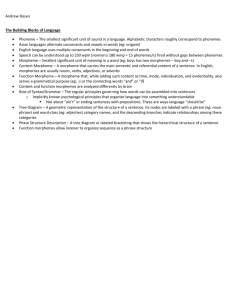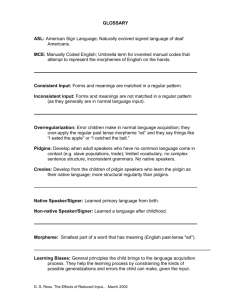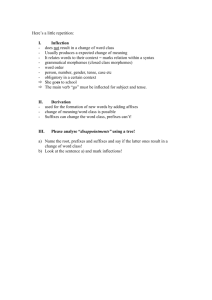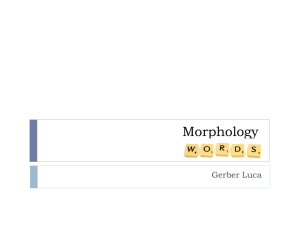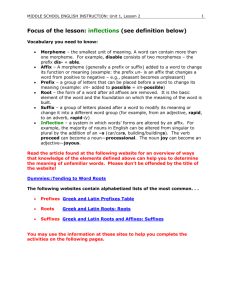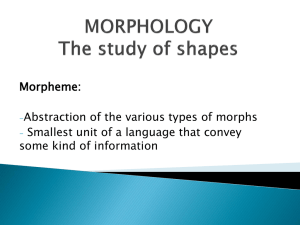Global Desk
advertisement
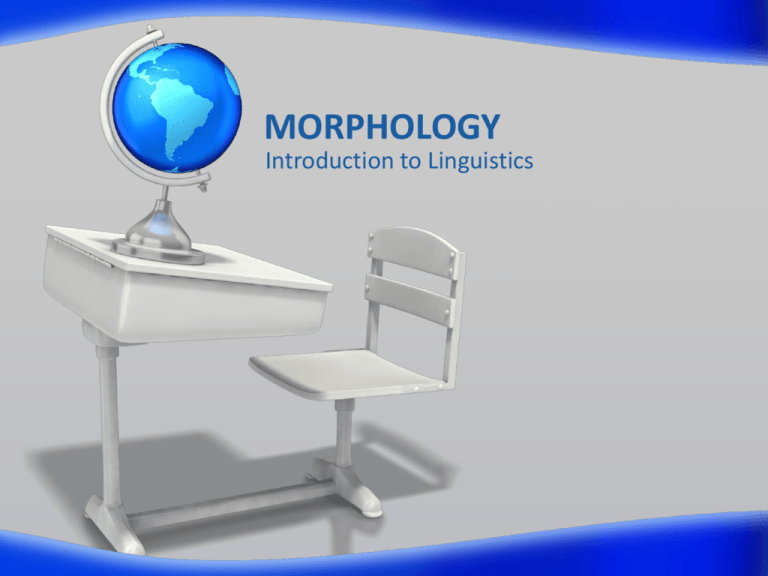
MORPHOLOGY Introduction to Linguistics •WHAT IS A WORD? •Grammatical categories of words • Words belongs to different grammatical categories/parts of speech. Nouns • Verbs • Adjectives • Prepositions • •Classes of words Content words Function/ grammatical words • Open class • New words can be added. • Nouns, verbs, adjectives, adverbs • Closed class • Impossible to add new function words • Conjunctions, prepositions, articles, pronouns. •Morpheme • The minimal unit of meaning • A smallest linguistic form in which its sound and meaning cannot be further divided and analyzed. • Example: Boy-s • Teach-er • Morphemes Bound morphemes -Attached to other morphemes Free morphemes -Occur independently •Bound morphemes 1 Prefix • The morpheme attached to the word-initial position • Un-organized • pre-pare? Suffix • The morpheme attached to the word-initial position • Teach-er, lingu-ist •Bound morphemes 2 Infix Circumfix • The morpheme attached in the middle of a word •B-um-ili ‘bought’ (Tagalog) • The morpheme attached to the word-initial and wordfinal positions • ge-spiel-t (German past participle) •HOW NEW WORDS ARE CREATED How to create new words • Compounds • Reduplication • Alternations • Acronyms • Back-formation • Abbreviations • Words from names • Blends • Borrowings •Compounds • • Two or more words are joined to form a new word Example • English • Girlfriend, Blackboard, Overdoes • German • Rheindampfschifffahrtsgesellschaftskapitänsstellvertreter • ("Rhine steamship-company vice-captain"). • Eisenbahn ("railway"): Eisen, "iron", + bahn, "track" • Autobahn Japanese • 神風 kamikaze • kami (god) and kaze (wind) •Reduplication • Total • reduplication The plurals of nouns (Indonesian) • Rumah • Partial • ‘house’ => Rumahrumah ‘houses’ reduplication The future tense (Tagalog) • Bili ‘buy’ => bibili ‘will buy’ • Pasok ‘enter’ => papasok ‘will enter’ •Alternations • Morpheme-internal Woman – women • Foot – feet • drink- drank-drunk • Give-gave-given • modifications •Acronyms Initials of several words • NASA • • FAQ • • Frequently Asked Questions FYI • • National Aeronautics and Space Agency For Your Information SARS • Severe Acute Respiratory Syndrome •More ACRONYMs •Abbreviations Alphabetic abbreviations (acronym) • Each letter is separately pronounced. • PC: personal computer • CD: compact disc Clipped abbreviations • Spelling and pronunciation are both shortened. • Prof : Professors • Gas: Gasoline • Doc: doctor Orthographic abbreviations • Spelling is shortened, but pronunciation is not. • Dr.: doctor • MB: megabyte •Back-formation Words resulted from an incorrect morphological analysis Editor • Edit Interpretation • Interpretate ? • Interpret •Words from names (eponyms) Names of products Proper names Xerox Sandwich Kleenex Nobel Mac Google •Blends Two words are partially joined to a new word. • Motel • • Brunch • • Motor + hotel Breakfast + lunch karaoke • Japanese word kara (meaning empty) + the clipped form oke of the English loanword "orchestra" (ōkesutora オーケストラ) •Borrowings Direct: a language ‘borrows’ a term directly from another language • • • • • • Croissant Kindergarten Sushi Dim sum Oolong Feng shui •Borrowings Indirect : a certain word is passed on from the source language to another (as a direct borrowing), and then from that language to another and to another Turkish kahveh Arabic kahva Dutch koffie English coffee •Exercise • Does Mandarin Chinese have the following ways to create new words? • • • • • • Compounds Acronyms Abbreviations Words from names Blends Borrowings •MORPHOLOGICAL TYPES OF LANGUAGES Morphological types of langauges Synthetic langauges Agglutinating langauges Fusional languages Polysynthetic langauges Analytic languages •Analytic/isolating langauges • They are made up of sequences of free morphemes used itself with meaning and function intact. • Mandarin Chinese •Synthetic langauges • Bound morphemes are attached to other morphemes. • The bound morphemes are attached To add another element of meaning ot he stem • To indicate the grammatical function of the stem in a sentence. • •Sythetic languages 1: agglutinating languages Personof-thesubject prefix Tense prefix Verb stem Agglutination Swahili [ni-na-soma] I-present-read ‘I am reading’ [u-na-soma] you-present-read ‘You are reading’ [a-na-soma] s/he-present-read ‘S/he is reading’ [ni-li-soma] I-past-read ‘I was reading’ [u-li-soma] you-past-read ‘You were reading’ [a-li-soma] s/he-past-read ‘S/he was reading’ •Sythetic languages 2: fusional/inflecting languages Stem affixes Spanish [habl-e] ‘I spoke’ [habl-o] ‘I am speaking’ [habl-a] ‘She is speaking’ Fusion/inflection •Sythetic languages 3: polysynthetic languages • • Extreme long agglutinating A certain degree of corporation (e.g., verbs and nouns together) Yup’ik Inuit (Payne, 1997) Tuntu- ssur- reindeer hunt qatar- ni- ksaite- ngqiggte- uq FUT say NEG again 3SG: IND 'He had not yet said again that he was going to hunt reindeer.' •HOW WORDS ARE WRITTEN •Types of writing system • Logographic writing system • Syllabic writing system • Alphabetic writing system •Logographic writing system The system uses a a single written character to represent a complete grammatical word (=a logogram) • Example • Chinese/hanzi; Japanese/kanji; Korean/hanja • Maya • Ancient Egyptian • •Syllabic writing system • The system uses a set of syllabic symbols to compose words. • Japanese hiragana, katakana. •Alphabetic writing system • The system uses a set of phonetic symbols (letters) to represent the sounds/phonemes of a language. • Examples Roman/Latin alphabet • Cyrillic alphabet • Arabic alphabet • Questions?



